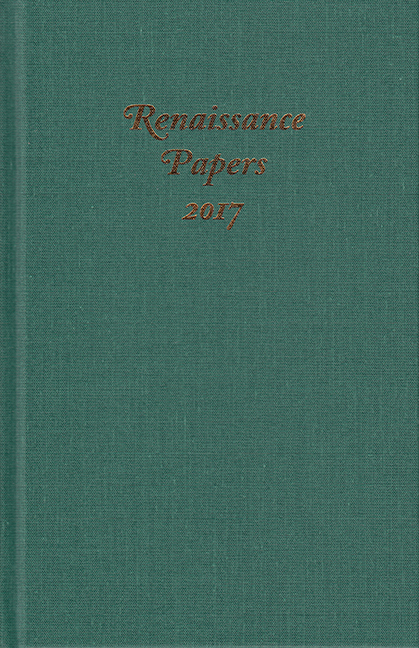Book contents
- Frontmatter
- Contents
- Dedication
- The Contested Pliability of Sacred Space in St. Paul's Cathedral and Paul's Churchyard in Early Modern London
- Classicism from Urbino: The Bichi Chapel Frescoes by Francesco di Giorgio Martini
- Visualizing the Paragone in Francisco de Zurbarán's Crucifixion with a Painter
- A Change in the Making: Shakespeare's Ovidian Sleep of Death and Display
- Old Black Rams and Mortal Engines: Transhumanist Discourse in Othello
- Dying with Speed and Felicity: Humor and Death in Book 3 of the Faerie Queene
- “If Devils Will Obey Thy Hest”: Devils in Dr. Faustus and The French Historie
- Rewriting Lucrece: Intertextuality and the Tale of Lucrece
- Economy and “Honesty” in Thomas Middleton's A Chaste Maid in Cheapside
- Glossing Authorship: Printed Marginalia in Aemilia Lanyer's Salve Deus Rex Judaeorum
- Botany and the Maternal Body in Titus Andronicus
- Unhorsing the Lustiest Challenger: Reflections on Chivalry in Richard II and Henry IV, Part 1
Visualizing the Paragone in Francisco de Zurbarán's Crucifixion with a Painter
Published online by Cambridge University Press: 04 April 2019
- Frontmatter
- Contents
- Dedication
- The Contested Pliability of Sacred Space in St. Paul's Cathedral and Paul's Churchyard in Early Modern London
- Classicism from Urbino: The Bichi Chapel Frescoes by Francesco di Giorgio Martini
- Visualizing the Paragone in Francisco de Zurbarán's Crucifixion with a Painter
- A Change in the Making: Shakespeare's Ovidian Sleep of Death and Display
- Old Black Rams and Mortal Engines: Transhumanist Discourse in Othello
- Dying with Speed and Felicity: Humor and Death in Book 3 of the Faerie Queene
- “If Devils Will Obey Thy Hest”: Devils in Dr. Faustus and The French Historie
- Rewriting Lucrece: Intertextuality and the Tale of Lucrece
- Economy and “Honesty” in Thomas Middleton's A Chaste Maid in Cheapside
- Glossing Authorship: Printed Marginalia in Aemilia Lanyer's Salve Deus Rex Judaeorum
- Botany and the Maternal Body in Titus Andronicus
- Unhorsing the Lustiest Challenger: Reflections on Chivalry in Richard II and Henry IV, Part 1
Summary
Introduction
FRANCISCO de Zurbarán's Crucifixion with a Painter (fig. 1) illustrates the devotional aspects of his religious imagery and suggests that artistic production is the result of a profound visionary experience with the artist ultimately acting as a mediator between the divine and the viewer. The subject of the crucified Christ with a painter in a dark, desolate and nondescript space raises complex questions concerning the nature of representation. The painting's idiosyncratic subject sets the context for this discussion. The Crucifixion with a Painter depicts an elderly artist standing at the foot of the Cross. He stands in the foreground in a three-quarters length pose. The painter raises his eyes to Christ and places his right hand over his heart in a gesture of piety and devotion as he holds his brushes and palette in his left hand. The palette held by the painter contains all of the colors used to paint the image to imply that the painter himself is the instrument of vision. One can argue that the artist is contemplating a vision of the crucified Christ that he has painted and has materialized before him. Given documents that support the artist's activity as a sculptor, the painter is perhaps contemplating a polychrome crucifix that he has just painted, its intense realism bringing it to life before him. This ambiguity, probably intentional, has led to widespread questioning of the painter's activity as depicted in the picture.
This work's unique subject thus raises important questions about the relative merits of painting and sculpture that form one of the core arguments of the paragone in early modern Spain. The term paragone refers to theoretical debates about the relative merits of painting and sculpture. The Spanish tradition of painting sculpture further complicates this academic debate. As Xavier Bray has rightly noted in a recent essay on “Velázquez and polychrome sculpture,” “Still to this day, historians find it difficult to join the arts of painting and sculpture and polychrome sculpture. The two techniques are studied in separate ways and are rarely considered as arts that had artistic conversations in the paintings of Velázquez and Zurbarán.”
In examining this “conversation” or close relationship between painting and sculpture in Golden Age Spain, this article discusses how Zurbarán envisions the paragone in this particular canvas.
- Type
- Chapter
- Information
- Renaissance Papers 2017 , pp. 31 - 48Publisher: Boydell & BrewerPrint publication year: 2018



